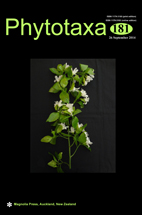Type: Article
Published: 2014-10-01
Page range: 96–109
Abstract views: 14
PDF downloaded: 1
Overview of Xanthoparmelia taxa from South Korea including the description of two new species (Parmeliaceae, Ascomycota)
Korean Lichen Research Institute, Sunchon National University, Sunchon 540–742, Korea
Departamento de Biología Vegetal II, Facultad de Farmacia, Universidad Complutense de Madrid, Plaza de Ramón y Cajal s/n, 28040 Madrid, Spain
Korean Lichen Research Institute, Sunchon National University, Sunchon 540–742, Korea
Korean Lichen Research Institute, Sunchon National University, Sunchon 540–742, Korea
Korean Lichen Research Institute, Sunchon National University, Sunchon 540–742, Korea
Korean Lichen Research Institute, Sunchon National University, Sunchon 540–742, Korea
ITS rDNA
molecular phylogeny
new species
endemic species
character distribution
pigmented medulla
volcanic rock

